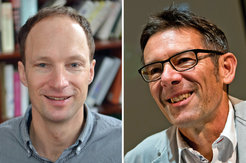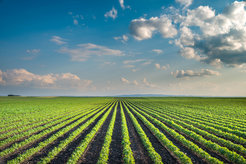"Knowledge can save species."
Walter Jetz and Martin Wikelski explain in an interview why species conservation receives less attention than climate protection
Increasingly more species are becoming extinct worldwide. And the number of plants and animals on earth is rapidly decreasing. Walter Jetz from Yale University and Martin Wikelski from the Max Planck Institute of Animal Behavior talk about the consequences this will have for humanity, how the global community plans to stop species extinction, and the fundamental role that science plays in all of this. The two scientists head the Max Planck – Yale Center for Biodiversity Movement and Global Change.
Why is biodiversity important for humans?

Martin Wikelski: Low biodiversity favours pests and pathogens. As a result, the risk of crop failures and pandemics increases. In turn, the decrease in beneficial insects threatens the pollination of important crops. Finally, the biodiversity crisis is exacerbating climate change. That’s because a large diversity of healthy ecosystems can more effectively slow the increase in temperature.
Walter Jetz: When biodiversity decreases, ecosystems become unstable. In the worst case, they collapse completely. The global extinction of species has the greatest consequences. For us humans, it takes far too long for species with similar ecological roles to re-emerge. For example, mammals have been separated from their closest relatives for over 1.5 million years on average. With every species we lose either locally or globally, the risk of collapse of local ecosystems or the global system as a whole increases. We thus have an ethical responsibility towards future generations to ensure that species do not become extinct because of us.
Everyone is talking about the climate crisis. Why does species extinction seem to cause less concern?
Jetz: In the case of climate change, the connections are clearer and more vivid. If the temperature increases, the sea level rises. The economic consequences are also more easily directly identifiable and obvious. And unlike climate, most endangered species are far away – for example in the tropics. Because of this greater distance and more ambiguous economic consequences, it is perhaps not surprising that the Intergovernmental Panel on Climate Change and its reports have been around for over 30 years but the Intergovernmental Science-Policy Platform on Biodiversity and Ecosystem Services for barely 10.
Wikelski: When it comes the biodiversity crisis, we are today where we were with climate change 20 years ago. At that time, people were unable to imagine the disastrous consequences of global warming. Take my birthplace, for example. At first glance, little has changed compared with the past. But there are far fewer insects than before. Perhaps that’s why there are no swallows now. The changes are still gradual. But in a few years, the consequences will be catastrophic. This gives me great cause for concern.
In many areas of the world, biodiversity has shrunk massively in recent decades. Nevertheless, the agricultural landscape of Central Europe is still highly productive. Conversely, tropical rainforests – a place of high biodiversity – are considerably less productive. How can that be?

Jetz: Of course, these areas are productive only thanks to active human intervention in the form of artificial fertilisers and pesticides. We do not know how resistant to change such ecosystems are and whether they will still be productive in 50 years. It is also a question of perspective. Rainforests may not be so productive for the local people. But they are all the more important for the global climate.
What are the main reasons for species extinction?
Jetz: At the moment, these are mainly the destruction of habitats through agriculture as well as settlement and road construction. In the coming years, climate change will further accelerate species extinction. Species that cannot adapt to the changes or evade them will become extinct. This is especially where science is needed. With the right foundations, we still have time to react in many cases and use our knowledge to help decision-makers reduce species extinction.
Where do you see the greatest need for research?
Wikelski: The major challenge is studying biodiversity changes globally and over the long term. With the new satellite-based observation system Icarus, for example, we can continuously track various animal species anywhere on Earth and link their positions to environmental data. This tells us what conditions the species need to survive. Conversely, we can use the animals as sensors for change.
Jetz: With new data sources – for example satellite-based or local sensors – and new theoretical and statistical approaches to linking information, we can decipher local, regional, and global relationships. This allows us to not only record biodiversity but also analyse the relationships between species as well as the reasons for changes in abundance and distribution. To this end, we have also established the Max Planck – Yale Center for Biodiversity Movement and Global Change. Unlike in climate science, there are no large research facilities for biodiversity where everything comes together. However, there is a great demand for research on global ecology and biodiversity. With its international orientation and long-term research approach, the Max Planck Society offers ideal conditions for this.
The UN Biodiversity Conference is taking place virtually and is scheduled to conclude in May 2022. How can it be ensured that the goals set at this conference will actually be achieved?
Jetz: Science is taking a more central role this time than at the conference in Aichi 10 years ago. Scientific findings are directly incorporated into the elaboration of the goals, and attempts are made to link the goals more closely to possible measurement. The countries involved must also report regularly on the state of biodiversity.

